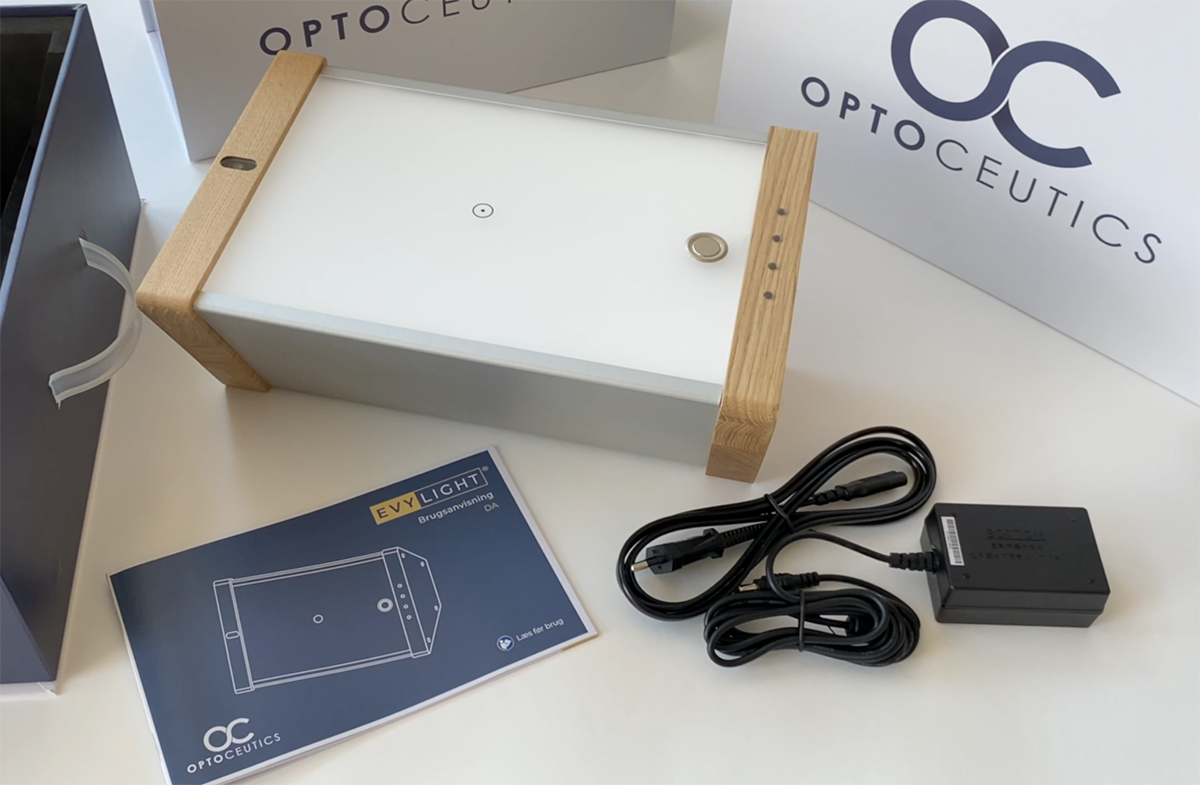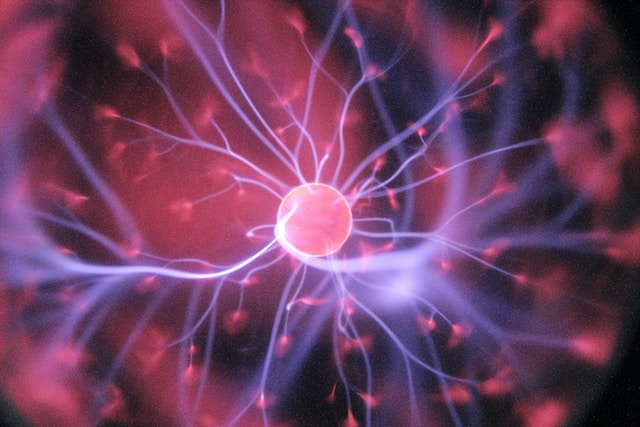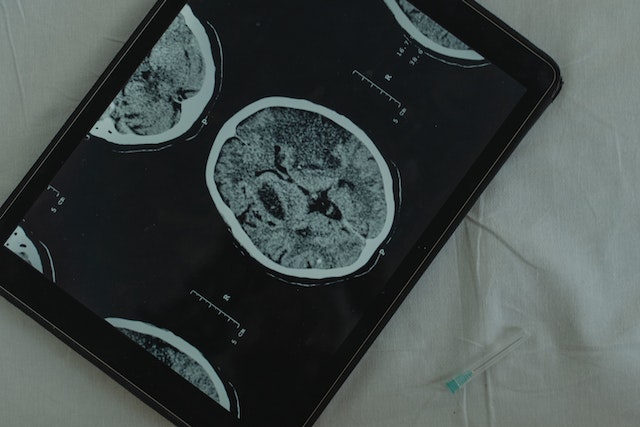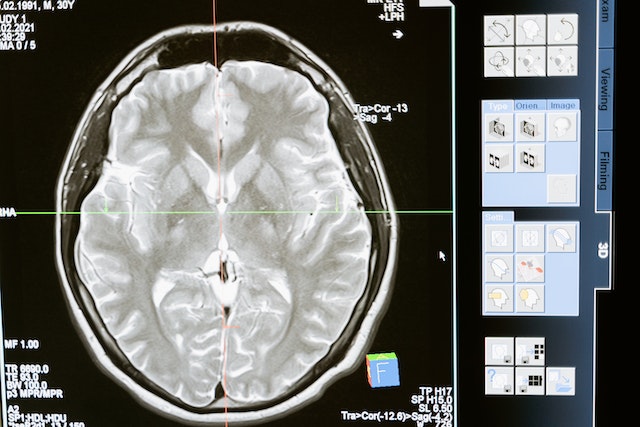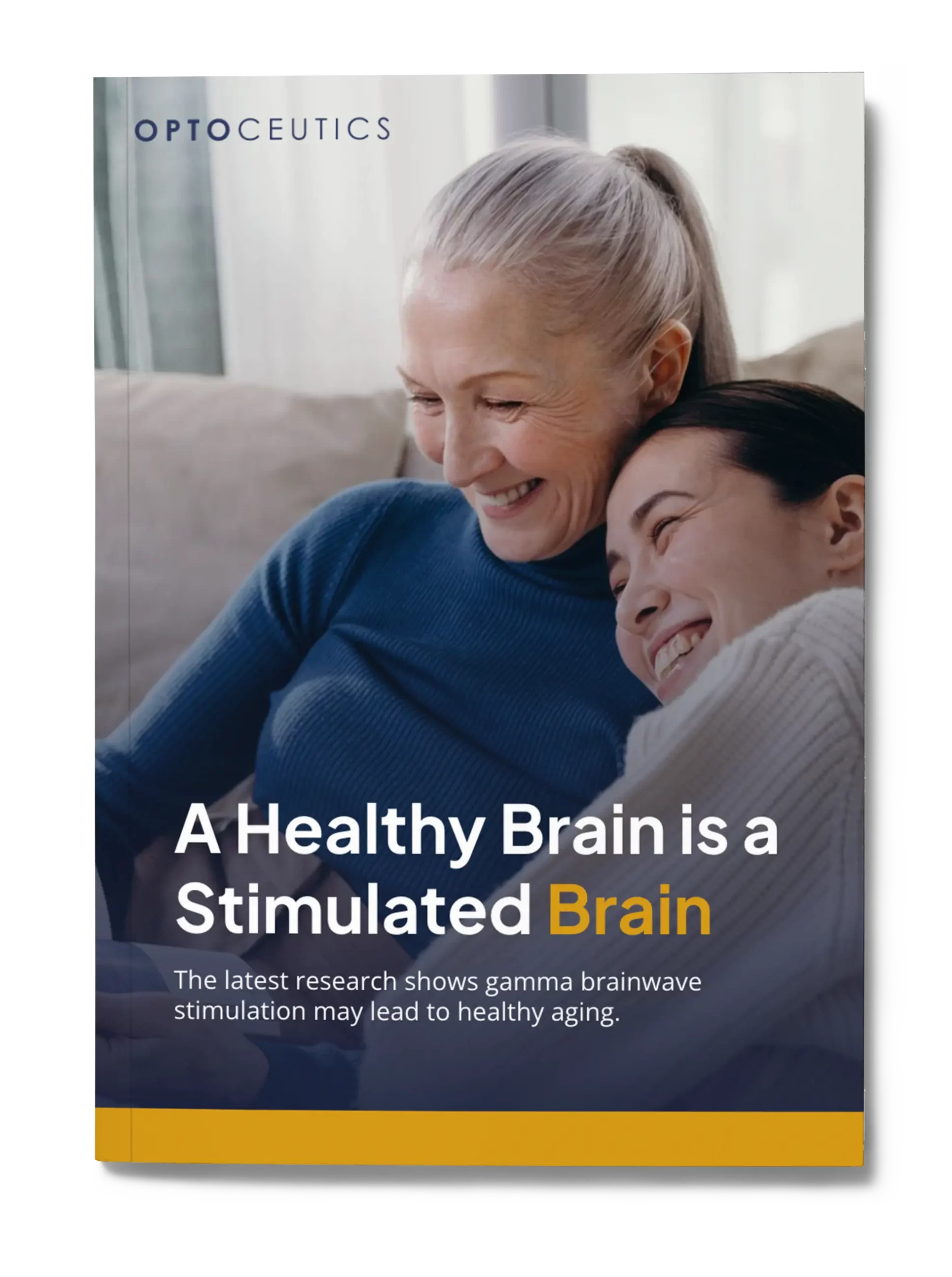Alzheimer’s disease is a neurodegenerative condition that dramatically affects cognitive and non-cognitive functions, particularly in older people. It affects short-term memory, language processing, reasoning, perception and a host of non-cognitive abilities. As the disease progresses, amyloid plaques accumulate in the brain which is associated with neuronal communication disruption and cell death. This leads to a progressive decline in cognitive and non-cognitive functions. Finding ways to lower amyloid plaque numbers could help slow the progression of this disease. Light therapy is a relatively new treatment being researched, which offers a non-invasive, drug-free alternative.
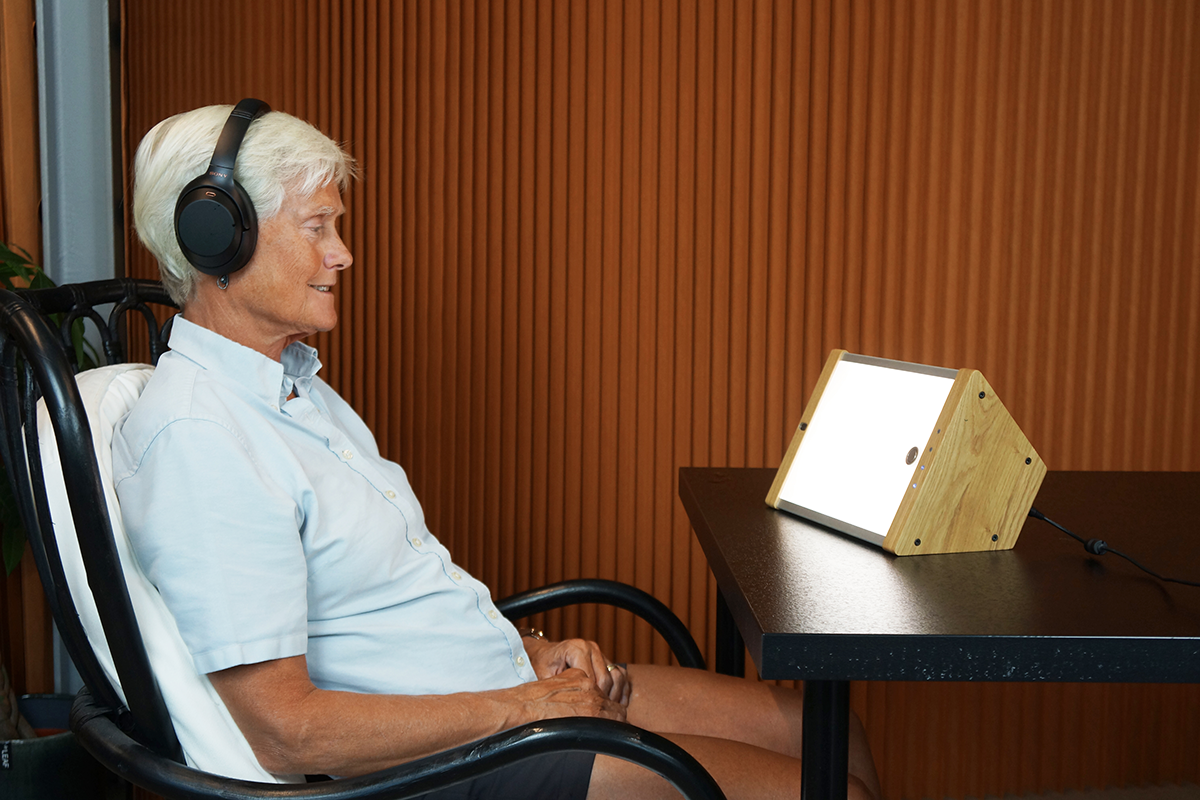
Christopher Ravn
Key Takeaways
1. Amyloid Alzheimer’s disease is a neurodegenerative condition that causes significant cognitive and non-cognitive decline over time.
2. Although there is no cure, several treatments are available – including light therapy for Amyloid Alzheimer’s.
3. This non-invasive, drug-free treatment works by synchronizing gamma brain waves and slowing the progression of the disease.
4. Even though the research is still new, companies like Optoceutics are shining a bright light on the possibilities of at-home use and providing hope where little previously existed.
Table of Contents
1. What Is Amyloid Alzheimer’s Disease?
2. What Is Light Therapy For Amyloid Alzheimer’s And What Are Its Benefits?
3. How Does The LED In The Light Help With Amyloid Alzheimer’s?
4. How Do You Perform A Light Therapy Session For Amyloid Alzheimer’s?
5. Ongoing Research And Clinical Trials In Light Therapy Treatments For Amyloid Alzheimer’s
6. Effects Of Light Therapy On Brain Functions In Amyloid Alzheimer’s
7. What Is The Best Type Of Light Therapy For Amyloid Alzheimer’s?
8. What Is The Best Device To Use With Light Therapy For Amyloid Alzheimer’s?
9. How Much Does Light Therapy For Amyloid Alzheimer’s Cost?
10. Can Light Therapy Be Detrimental If You Have Amyloid Alzheimer’s?
11. Frequently Asked Questions About Light Therapy For Amyloid Alzheimer’s
What Is Amyloid Alzheimer’s Disease?
Amyloid Alzheimer’s disease, sometimes referred to as amyloidosis, is a subtype of Alzheimer’s disease that features pronounced levels of amyloid protein in the brain. As these proteins grow in numbers, they begin to clump together – creating amyloid plaques. These plaques negatively interact with cells in the brain, causing issues with cell functionality.
When the amyloid plaques begin to impact the cells in the brain, many of the classic Alzheimer’s symptoms start to present themselves. This includes problems like memory loss, a general cognitive decline and changes in behavior and sleep patterns. The amyloid hypothesis suggests that it’s the amyloid plaques themselves that are responsible for Alzheimer’s symptoms.
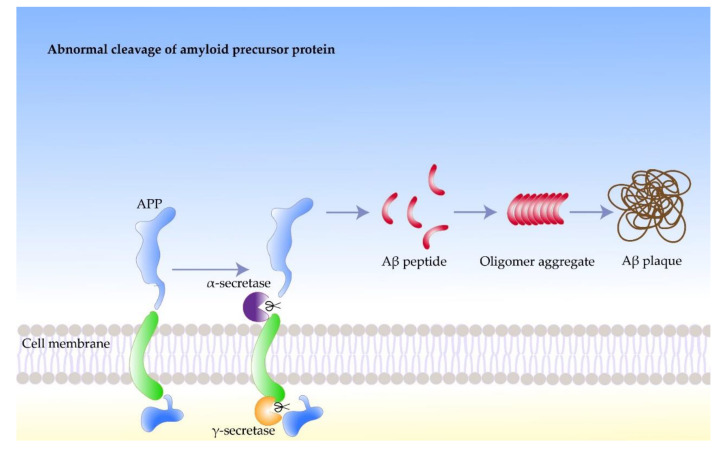
What Is Light Therapy For Amyloid Alzheimer’s And What Are Its Benefits?
Light therapy treatment for Amyloid Alzheimer’s is a relatively new form of treatment that works in an incredibly novel way. This non-invasive, drug-free treatment uses a specific pulse of light – set at a frequency of 40 Hz – to sync gamma waves and recondition parts of the brain. Emerging research indicates that this type of treatment could help manage the symptoms of Amyloid Alzheimer’s.
The benefits associated with this treatment appear to help with both cognitive and non-cognitive abilities. Cognitive benefits include enhanced short-term memory retention, improved attention spans and a stronger grasp of language. Non-cognitive improvements included reversal of behavioral changes such as mood stabilization and improved sleep patterns.
Can Light Therapy Help With Amyloid Alzheimer’s?
Based on clinical studies and other forms of research, it appears as though light therapy could prove to be a viable route of treatment for Amyloid Alzheimer’s. Although research is still fresh and ongoing, a reasonable body of evidence has emerged to point to the benefits of light therapy for Alzheimer’s disease. This includes everything from improving memory recall in Alzheimer’s patients to slowing the progression of the disease.
It is worth noting that more research is needed in order to fully verify the results from these studies. At the moment, though, all of the evidence is pointing to this type of therapy offering many benefits to people with Amyloid Alzheimer’s.
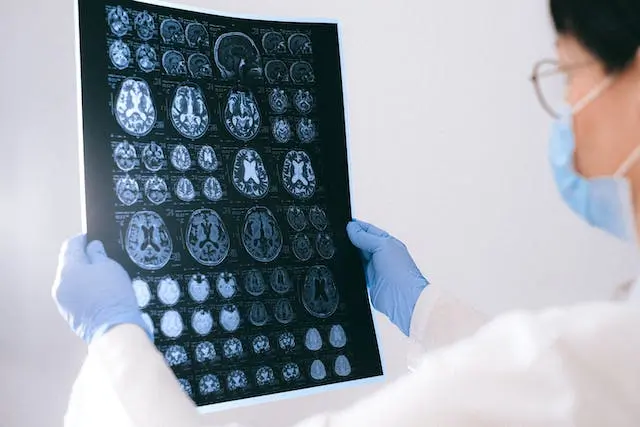
Other Treatments Compared To Light Therapy For Amyloid Alzheimer’s
Other treatments are already available for Amyloid Alzheimer’s, although they only offer marginal benefits to patients. Drugs such as Leqembi, galantamine, rivastigmine, and donepezil are regularly prescribed to help with some of the symptoms associated with Amyloid Alzheimer’s. However, they have limited scope and are only suitable for certain stages of the disease. What’s more,some come with a high level of risk due to their potential side effects.
In contrast to this, light therapy for Amyloid Alzheimer’s appears to have no significant side effects and is deemed safe to use. This is important for a few reasons, primarily because it makes light therapy a viable treatment for Alzheimer’s. It also allows for this type of therapy to work as a complementary treatment alongside medication without causing additional adverse side effects.
How Does The LED In The Light Help With Amyloid Alzheimer’s?
In order for light therapy to effectively synchronize the gamma waves in a patient’s brain, the light used must be set to a frequency of 40Hz. The most effective way to do this is by using multiple variated colored bulbs attached to a micro chip and board. Without this ability, the process could not be efficiently achieved.
How Do You Perform A Light Therapy Session For Amyloid Alzheimer’s?
Light therapy treatment for Amyloid Alzheimer’s doesn’t require the use of any medication or special techniques. Instead, it utilizes a light therapy lamp to shine light at a set frequency, helping to synchronize gamma brain waves. As a result of this, it is quite a simple procedure that can be undertaken at home if you have the proper equipment.
The most important thing to get right is the type of lighting used. It must be able to work at a frequency of 40 Hz to properly synchronize with your gamma brain waves. You should also consider that most devices use stroboscopic 40 Hz light, which many people can’t tolerate. EVY LIGHT is an innovative alternative that uses patented Invisible Spectral Ficker (ISF) technology which is more accessible. Here is how a typical treatment works:
- Set the Light Up: First, make sure the light is in the correct position. Set it on a flat surface and place it around 2 feet away from yourself.
- Turn on the Device: Next, turn on the light so that it is cast over your face. You don’t need to look at the light for it to work, just make sure it is shining on you.
- Consistency is a Key Element. Use it once a day at around the same time.
- Leave it Alone: You don’t need to interact with the lamp once you switch it on. This gives you the freedom to read a book, watch television or talk with someone during your session.
What Is The Best Device To Use With Light Therapy For Amyloid Alzheimer’s?
If you’re looking to use a light therapy device to help with Amyloid Alzheimer’s, there are a few things to consider. You need to find a device that is capable of creating a pulse of light at 40Hz and is designed for this type of treatment. Also, not all 40 Hz lights are created equally. The basic variety is a stroboscopic light, which is just like it sounds, a strobe light. However, few people can tolerate that kind of light intensity without becoming nauseous or dizzy.
An alternative is Invisible Spectral Ficker (ISF), which is a patented technology developed by OptoCeutics and is far more tolerable, making it easier to consistently use. Some hospitals may have these lights available as part of their Alzheimer’s treatment plan, but this isn’t a guarantee. You can also purchase specially designed light therapy lamps from OptoCeutics. These offer all of the functionality required for light therapy in a neat, convenient package. You can use it in the comfort of your own home and it is incredibly easy to set up.
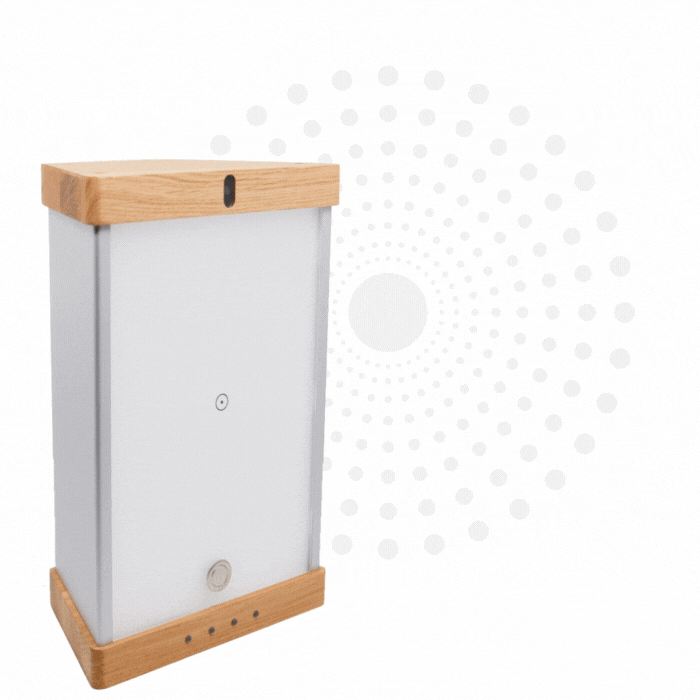
Enhance your brain performance through the power of light.
Comfortable and easy to use 40Hz light therapy to support and improve your brain function.
View Our LightOngoing Research And Clinical Trials In Light Therapy Treatments For Amyloid Alzheimer’s
Due to the promising nature of many of the studies surrounding light therapy, Amyloid Alzheimer patients are keen to see the ongoing research in this area. Research from OptoCeutics is also showing a great deal of promise, which looks at using ISF technology to provide treatment for Amyloid Alzheimer’s.
Moreover, some long-term trials and studies are already under way. The National Institute for Health has begun a years-long study into the efficacy of light therapy treatments for Amyloid Alzheimer’s, so over time the body of evidence around this treatment will grow.
Effects Of Light Therapy On Brain Functions In Amyloid Alzheimer’s
There have been several exciting findings from the various studies around light therapy treatment for Amyloid Alzheimer’s. One particular area that could prove to be life-changing for people suffering from this disease is how light therapy can impact brain functionality in a positive way. It appears as though the treatment can enhance cognition in participants with Alzheimer’s in a few different ways, such as:
- Neuroprotection and Neurogenesis: Researchers discovered that light therapy could enhance neuroprotection in brain cells, as well as encourage new cell growth.
- Enhanced Mood Stabilization: Amyloid Alzheimer’s often causes mood imbalances in patients, causing issues such as depression. Light therapy looks to provide enhanced mood stabilization which mitigates this issue.
- Amyloid Plaque Decrease: Most notable for Amyloid Alzheimer’s, light therapy could potentially reduce their number in the brain. This could slow the progression of the disease.
- Circadian System: It is believed that light therapy can synchronize the circadian system in the brain, helping Amyloid Alzheimer’s patients to enjoy a more structured sleep pattern.
- Memory Recall: Memory loss is a key indicator of advanced Alzheimer’s, but light therapy could potentially reverse this problematic symptom.
Effect Of Light Therapy On Behavioral Changes
Amyloid Alzheimer’s has an expansive list of symptoms, but one of the more prevalent involves a change in certain behaviors. Issues like unregulated sleep patterns, agitation or aggression are common issues found in Alzheimer’s patients, especially as the disease progresses. However, light therapy can potentially slow or stop these behaviors from occurring. This can create a positive feedback loop where other issues, like memory loss, are improved.
If the treatment is successful, then Amyloid Alzheimer’s patients will experience fewer disturbed behaviors. This, in turn, can help offer an enhanced quality of life by helping with sleep regulation, mood regulation, and even memory retention. What’s more, this type of treatment can work alongside other treatments, such as medication. This allows for a more wide-reaching treatment regimen for patients, offering improved outcomes.
The Circadian System In Amyloid Alzheimer’s Disease
The circadian system in patients with Amyloid Alzheimer’s disease is usually dysfunctional, especially as the disease progresses. This has a number of negative effects for the patient, including trouble maintaining a sleep pattern and mood swings. So finding a way to adjust these circadian systems could help mitigate these problems.
Light therapy can directly affect the gamma waves in the brain by synchronizing it to the correct frequency of 40 Hz. In doing so, many of the symptoms found in Amyloid Alzheimer’s, such as poor sleep patterns or changes in mood diminish greatly.
We Believe Prioritizing Brain Health Enhances Your Quality Of Life
Get to know our team, our mission and how our EVY LIGHT® can provide you and your loved ones with a fuller life, letting you breathe a little easier.
What Is The Best Type Of Light Therapy For Amyloid Alzheimer’s?
There are several different types of light that can be used for light therapy treatments. The type you choose will depend on what outcomes you’re looking for. The different types of light used include:
- 40Hz Light Therapy: This therapy uses light flickering at 40 Hz to promote gamma wave brain activity, which looks to activate neurons and eliminate amyloid plaques in the brain.
- Bright Light Therapy: This form of light uses bright light throughout the treatment. It is used to help synchronize the gamma brain waves back to 40 Hz, which can help with sleep pattern issues.
- Blue Light Therapy: Blue light therapy utilizes a calming blue light during the session. The main aim of this therapy is to improve both sleep patterns and mood.
What Is The Best Device To Use With Light Therapy For Amyloid Alzheimer’s?
The most important factor to look at when selecting a device to use for Amyloid Alzheimer’s light therapy is that it can be set to the right frequency. When dealing with Amyloid Alzheimer’s, 40 Hz is the standard used to perform light therapy sessions. Optoceutics has designed a product which works at this exact frequency. It is simple to use, cost-effective and offers all of the functionality required to perform a light therapy session.
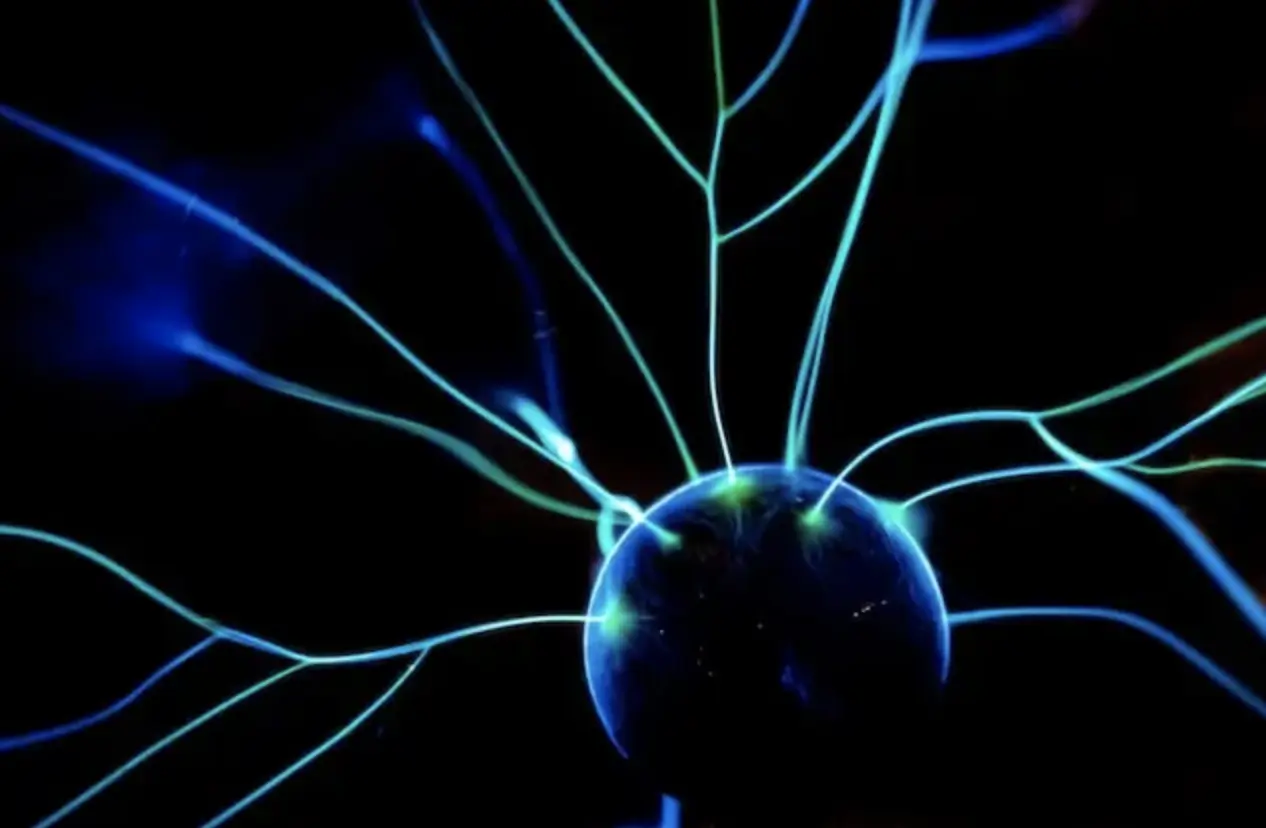
How Much Does Light Therapy For Amyloid Alzheimer’s Cost?
The costs associated with light therapy treatment for Amyloid Alzheimer’s largely depend on where you receive treatment. Clinical settings, such as in hospitals, will likely cost you quite a lot as you’ll have to work through health insurance providers.
Alternatively, investing in an at-home light therapy lamp gives you the chance to benefit from light therapy without using clinical services. You also have the freedom to undertake therapy sessions at your own leisure with the use of EVY LIGHT® and in the comfort of your own home.
Learn What Others Have Experienced with EVY Light
See how others have achieved a sharper mind by activating their gamma brainwaves in combination with maintaining a healthy lifestyle.
Can Light Therapy Be Detrimental If You Have Amyloid Alzheimer’s?
Most of the research surrounding light therapy for dementia points to it being incredibly safe and devoid of any significant side effects depending on the type of light you use. Stroboscopic light can cause dizziness, headaches and even seizures. In contrast to this, using Invisible Spectral Flicker technology mitigates all of these issues by using a light pulse that is indiscernible to the naked eye.
There are also certain individuals who may experience detrimental effects from light therapy. So, if you have any of the following conditions, it is wise to speak with a medical professional before undergoing light therapy treatment:
- Conditions affecting your eyes, such as retinal disease.
- Various types of skin sensitivity, such as dermatitis.
- Behavioral disorders such as bipolar disorder.
- Sensitivity to light or prone to migraines.
Frequently Asked Questions About Light Therapy For Amyloid Alzheimer’s
What Is The Best Light Therapy For Amyloid Alzheimer’s?
The best light therapy for Amyloid Alzheimer’s is one that utilizes the 40 Hz frequency. Research has shown that this form of light therapy can synchronize the gamma brain waves, which are dysfunctional in people with Alzheimer’s disease. EVY LIGHT® appears to promote neuron activation and may eliminate amyloid plaques in the brain.
How Does Light Help People With Amyloid Alzheimer’s Disease?
Light therapy uses light set at a particular frequency of 40 Hz to help synchronize gamma waves in the brains of patients. In those suffering from Amyloid Alzheimer’s, this can help alleviate certain symptoms or slow the onset of the disease.




